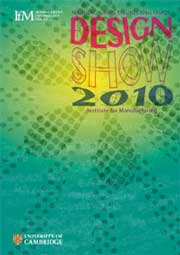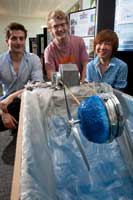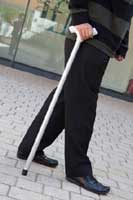Design Show 2010
|
The Design Show is held each year for an invited audience of local industrialists and designers. Students put together displays to explain the technical and business ideas behind the products, together with design details and prototype models of the products themselves. |
 |
|
|
|
||
Design projects |
||
E3 |
||
|
An urban vehicle concept with a retractable wheel base that enables the vehicle to park in small spaces Parking space is at a premium in many of today’s modern and congested cities. Statistics from research at MIT show that approximately 40% of fuel is used in the search for a space in which to park. Reducing this excessive, wasteful and environmentally damaging use of fuel is an important part of reducing the effects of emissions from vehicles.
Having the minimum sized passenger compartment for 2 people and luggage the E3 has a passenger pod of 1.4 x 1.35m. This pod size enables 3 vehicles to be parked in a normal sized parking space. However, the size of this wheelbase causes instability at speed. We have therefore created a retractable wheelbase concept that enables stability whilst driving, but maintains the small size when the vehicle is parked.
Team: Emma Burrow, Julia Toynton, Sufyan Khan, Robert Hayes |
|
|
Ascend |
||
|
An integrated foot and ankle prosthetic offering greater flexibility at a competitive price
|
 |
|
Post-me |
||
|
Your picture is worth a postcard
Post-Me is a fixed unit incorporating a camera and printer. The device has been designed to operate as simply as possible – the tourist inserts the coins, a photo is taken and then printed out as a postcard. There are no similar products that provide these functions in one system. We will work with tourist attractions to place our devices in locations that guarantee the perfect photo.
|
 |
|
FlikStik |
||
|
Improving quality of life for MS sufferers
|
|
|
SharpSure |
||
|
A solution to the need for safe and effective disposal of Auto-Disable syringes appropriate for the developing world
Our solution involves separating the ‘sharps’ or needles from the less dangerous plastic syringe body at the point of use, thus reducing the volume of critical waste produced. This makes appropriate incineration and transport to incineration facilities feasible where it has before not been an option. We have re-designed the syringe itself to make the separation action and the equipment as cheap, simple and safe as possible.
Team: Adrian Wallis, Harry Simpson, Luke Jesson |
 |
|
FloDrive Turbine |
||
|
Easy-to-install hydropower generator
This design is a small run-of-river hydropower solution, initially capable of providing up to 1 kW of power in rivers. The main product offering consists of a turbine, generator unit and supporting structure. It weighs approximately 500 kg and is 12 x 0.5 x 1 m when deployed, but compacts to a box of 3 x 2 x 2 m for transporting.
The FloDrive Turbine is intended to be as easy to install as possible, with no special infrastructure required. It should take less than a day to install, require no specialist equipment, and would be possible for untrained individuals to accomplish a successful installation. The electricity generated would be output in DC to charge batteries or AC to power homes, complementing available grid power.
Team: Deniz Erkan, Ned Stuart-Smith, Li Jiang |
 |
|
The Mark 1 |
||
|
The Africa wheelchair revolution The World Health Organisation estimates that around 150 million people in the world's poorest countries who would benefit from a wheelchair, cannot afford one. Charities struggle to address this need due to the sheer scale of the problem, and often deliver donated chairs which cannot meet the requirements of all-terrain use.
Our design aims to address these issues by designing an affordable wheelchair from scratch to meet its user’s needs. Excluding the wheels, existing wheelchairs are assembled from around 100 components; the Mark 1 has only three: two sides of a chassis and the chair it supports, at a material cost of under $10. The three-wheeled configuration allows for greater manoeuvrability over rough terrain, and front-driven wheels benefit users with limited shoulder movement and strength. By careful material selection and design for mass manufacture, the potential scale of production would make a sizeable impact on meeting the needs of those who currently cannot afford a wheelchair.
Team: Xiong Chang, Sophie Burgess, Chris Stanyon |
 |
|
LifeCycler |
||
|
A bicycle that grows
|
 |
|
MakeAShape |
||
|
Combining construction and creativity in a product where imagination is the key
|
 |
|













